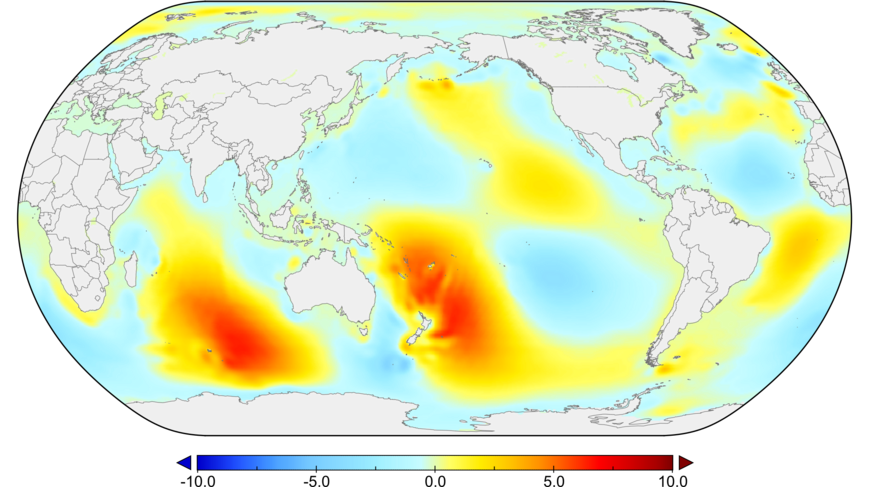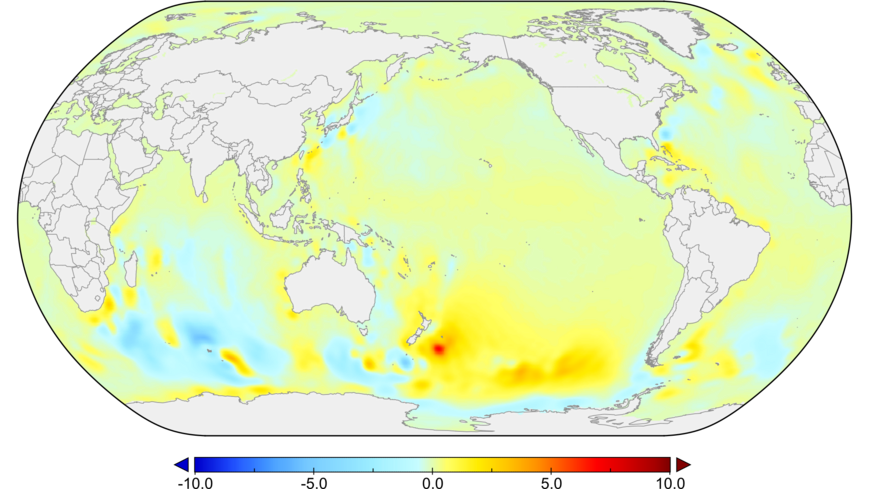The world ocean is good conductor of electricity, due to its high concentration of dissolved salts. As the electrically conducting seawater moves around the Earth, it permanently interacts with the ambient magnetic field generated in the Earth’s core. During this process, the positively and negatively charged salt-ions in the sea-water are deflected by the Lorentz force, which leads to spatial accumulation of electric charge and, in turn, weak electric currents in the entire ocean basin. These oceanic electric currents induce characteristic magnetic signals in the range of a few nanotesla (nT) that are mainly proportional to combined transports of water, heat, and salinity in the ocean.
Observations of this so-called motional induction process (e.g., by magnetometers mounted on satellites, land stations, or submarine cables) allow to indirectly observe these integral oceanic quantities extending from the sea surface to ocean bottom. Low-Earth-orbit satellites, e.g., ESA’s satellite trio Swarm that launched in November 2013, survey the geomagnetic field globally and can detect the weak oceanic magnetic field component. In particular, the periodic magnetic field generated by the lunar semi-diurnal (M2) ocean tide is readily separable from Swarm observations. However, since such magnetic field observations contain signals from various different superimposed electromagnetic sources, the weak and irregular oceanic magnetic signals generated by the ocean circulation have not yet been separated in satellite observations.
Our ongoing investigation of the motional induction process in the ocean aims to identify and establish novel ocean observation techniques that utilize ocean-induced magnetic signals. The subsequent combination with further ocean observation methods, e.g., satellite altimetry or gravimetry, will allow comprehensive insights into large-scale ocean dynamics.

Figure: Tidally (M2) induced magnetic field at sea surfache [nT]. Please click on this link to start the animation.
Ocean tide induced magnetic signals (Fig. 1) can be used to monitor processes in the ocean, which are attributed to climate change. In particular, the well-known periodic M2 tidal magnetic signals contain trends, which are related to long-term changes in sea-water conductivity and, in turn, oceanic heat and salinity contents (Saynisch et al., 2016). Consequently, long observational records of tidally induced magnetic signals could serve as an additional measure of ocean warming and ocean heat budget (Saynisch et al., 2017, Irrgang et al., 2019). A particular application in this context is the investigation of anomalies in the M2 tide magnetic field due to changes in the ocean's heat and salinity distribution during El Nino events (Petereit et al., 2018). Besides these sensitivty studies, we continuously examine the robustness of numerical simulations of electromagnetic induction in the ocean (Saynisch et al., 2018b).

Figure: Ocean circulation induced magnetic field at sea surface [nT]. Please click on this link to start the animation.
Ocean circulation induced magnetic signals (Fig. 2) have the potential to be utilized for the correction of ocean circulation models. Therefore, we examine ocean-induced magnetic fields by combining numerical forward models of the general ocean circulation with electromagnetic induction models. These model combinations are used to characterize oceanic magnetic signals in terms of intensity, spatio-temporal patterns, and sensitivity towards oceanographic quantities (Irrgang et al., 2016a, 2018). Additionally, ensemble-based studies are performed to measure the confidence of simulated motional induction (Irrgang et al., 2016b). In combination, this knowledge is used to perform data assimilation studies that aim to constrain forward simulations of ocean general circulation models with observations of oceanic magnetic signals (Irrgang et al., 2017). Together with additional ocean observing systems (e.g., satellite altimetry), our models and tools allow us to test new approaches for detecting oceanic magnetic signals in satellite observations (Saynisch et al., 2018a).
This work was funded by Deutsche Forschungsgemeinschaft (DFG) within the first phase of the SPP 1788: "Study of Earth system dynamics with a constellation of potential field missions" in the project "Detectability of non-tidal ocean signals in Earth's magnetic field (OceanMag)". Since 2019, this research is continued in the second phase of the SPP within the project OceanMag-II.
Funding: DFG - German Research Foundation
Status: current
Website: http://www.spp-dynamicearth.de/the-projects/geomagnetic-field/
Publications
- Irrgang, C., Saynisch, J., Thomas, M. (2017). Utilizing oceanic electromagnetic induction to constrain an ocean general circulation model: A data assimilation twin experiment. Journal of Advances in Modeling Earth Systems, 9, 3, 1703–1720, doi:10.1002/2017MS000951.
- Saynisch, J., J. Petereit, C. Irrgang, and M. Thomas (2017). Impact of oceanic warming on electromagnetic oceanic tidal signals: A CMIP 5 climate model based sensitivity study. Geophysical Research Letters, 44, 4994–5000, doi:10.1002/2017GL073683.
- Saynisch, J., J. Petereit, C. Irrgang, A. Kuvshinov, and M. Thomas (2016). Impact of climate variability on the tidal oceanic magnetic signal—A model-based sensitivity study. Journal Geophysical Research Oceans, 121, 5931–5941, doi:10.1002/2016JC012027.
- Irrgang, C., Saynisch, J., Thomas, M. (2016b). Ensemble simulations of the magnetic field induced by global ocean circulation: Estimating the uncertainty. Journal of Geophysical Research Oceans, 121, 3, 1866–1880, doi:10.1002/2016JC011633.
- Irrgang, C., Saynisch, J., Thomas, M. (2016a). Impact of variable seawater conductivity on motional induction simulated with an ocean general circulation model. Ocean Science, 12, 1, 129-136, doi:10.5194/os-12-129-2016.
- Irrgang, C., Saynisch-Wagner, J., & Thomas, M. (2018). Depth of origin of ocean-circulation-induced magnetic signals. Ann. Geophys., 36(1), 167–180. doi:10.5194/angeo-36-167-2018.
- Saynisch, J., Irrgang, C., & Thomas, M. (2018b). Estimating ocean tide model uncertainties for electromagnetic inversion studies. Ann. Geophys., 36(4), 1009–1014. doi:10.5194/angeo-36-1009-2018.
- Saynisch, J., Irrgang, C., & Thomas, M. (2018a). On the Use of Satellite Altimetry to Detect Ocean Circulation’s Magnetic Signals. J. Geophys. Res. Oceans, 123(3), 2305–2314. doi:10.1002/2017JC013742.
- Petereit, J., Saynisch, J., Irrgang, C., Weber, T., & Thomas, M. (2018). Electromagnetic characteristics of ENSO. Ocean Sci., 14(3), 515–524. doi:10.5194/os-14-515-2018.
- Irrgang, C., Saynisch, J., & Thomas, M. (2019). Estimating global ocean heat content from tidal magnetic satellite observations. Sci. Rep., 9, 7893. https://doi.org/10.1038/s41598-019-44397-8



